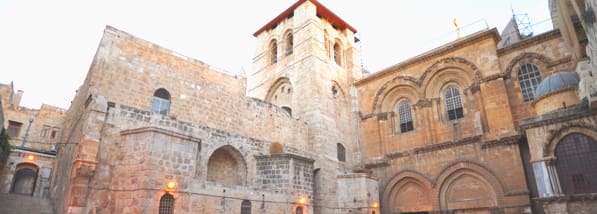With the beginning of Holy Week, we all turn our attention to Jesus’ Passion. In Jerusalem, the events of this week are commemorated throughout the Old City. Today, we’re going to explore the Church of the Holy Sepulchre, built atop Calvary and Jesus’ tomb. For a great online virtual tour, check out this amazing site.
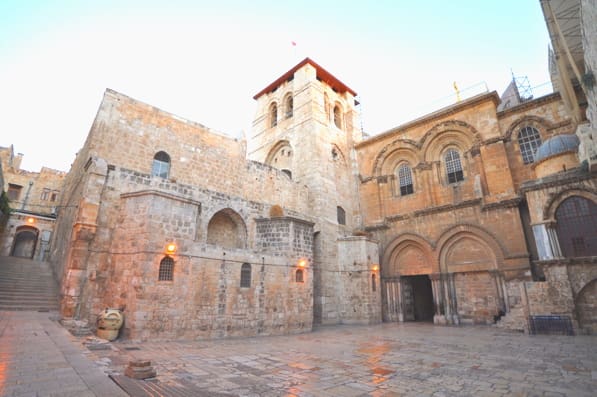 The exterior of the Church of the Holy Sepulchre is unremarkable except in its plainness. It was built by the Crusaders in 1149 AD atop the ruins of a church built in the fourth century by St Helena, the mother of Constantine. Today, control over the Church is shared by Roman Catholics, Greek Orthodox, Armenian Orthodox, Syriac Orthodox, Coptic Christians and Ethiopian Orthodox.
The exterior of the Church of the Holy Sepulchre is unremarkable except in its plainness. It was built by the Crusaders in 1149 AD atop the ruins of a church built in the fourth century by St Helena, the mother of Constantine. Today, control over the Church is shared by Roman Catholics, Greek Orthodox, Armenian Orthodox, Syriac Orthodox, Coptic Christians and Ethiopian Orthodox.
Because of the many chapels in this church, it can be somewhat overwhelming and confusing. We’ll go room by room, using a floor plan.
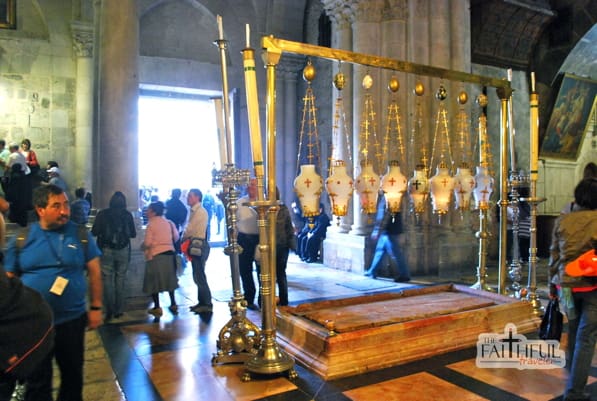 The main entrance sits between Calvary and the tomb. When you walk in, the first thing you see is the stone of anointing. Dating back to 1810, there’s no way this could be the stone on which Jesus’ body was placed for anointing after his death, but pilgrims kiss it anyway. I did, too. Behind the stone is a large mosaic of Christ being taken down from the cross, his body being prepared for burial, and being placed in the tomb.
The main entrance sits between Calvary and the tomb. When you walk in, the first thing you see is the stone of anointing. Dating back to 1810, there’s no way this could be the stone on which Jesus’ body was placed for anointing after his death, but pilgrims kiss it anyway. I did, too. Behind the stone is a large mosaic of Christ being taken down from the cross, his body being prepared for burial, and being placed in the tomb.
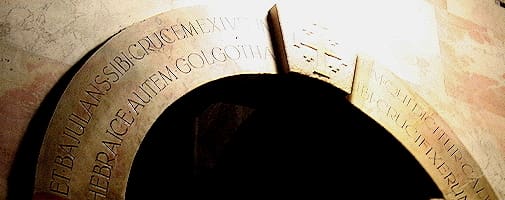
 On the right is an archway, carved with words from John 19: “carrying the cross himself, he went out to what is called the Place of the Skull, in Hebrew, Golgotha. There they crucified him.” Steep stairs lead to the top of Calvary. The Catholic chapel where it is believed that Jesus was nailed to the cross comes first. Mosaics illustrate His crucifixion, the holy women at the foot of the cross, and the sacrifice
On the right is an archway, carved with words from John 19: “carrying the cross himself, he went out to what is called the Place of the Skull, in Hebrew, Golgotha. There they crucified him.” Steep stairs lead to the top of Calvary. The Catholic chapel where it is believed that Jesus was nailed to the cross comes first. Mosaics illustrate His crucifixion, the holy women at the foot of the cross, and the sacrifice 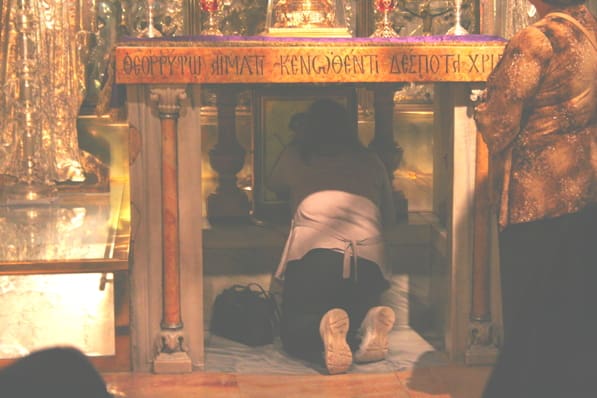 of Isaac. Next to this chapel is the Greek Orthodox chapel, festooned with gold lamps and a large image of Jesus on the cross.
of Isaac. Next to this chapel is the Greek Orthodox chapel, festooned with gold lamps and a large image of Jesus on the cross. 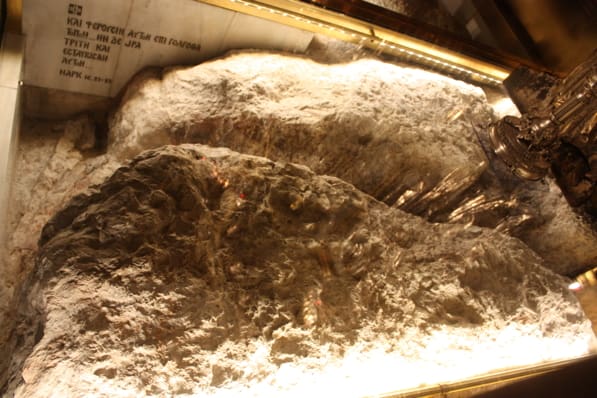 Pilgrims kneel under an altar and place their hand in a small hole to touch the rock that held Jesus’ cross. It sounds so commonplace, but think about it: they touch the rock that held Jesus’ cross.
Pilgrims kneel under an altar and place their hand in a small hole to touch the rock that held Jesus’ cross. It sounds so commonplace, but think about it: they touch the rock that held Jesus’ cross.
 Back on the ground floor, as we make our way into the church, we come to a small Armenian shrine
Back on the ground floor, as we make our way into the church, we come to a small Armenian shrine  dedicated to the Holy Women, who kept watch during Christ’s crucifixion and death.
dedicated to the Holy Women, who kept watch during Christ’s crucifixion and death.
The Constantinian rotunda is supported by arched walls, dating to Constantine’s original basilica, and is topped with a spectacular dome. In the center of the dome, a window lets in light, and a star design, with twelve tongues of light, represents the apostles.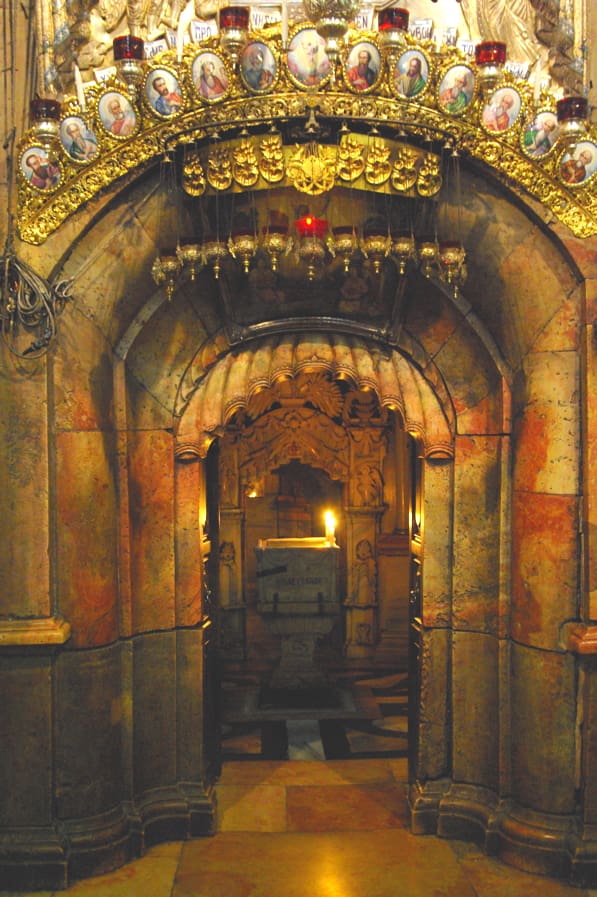
The aedicule sits in the center of the rotunda, housing Jesus’ tomb. Inside, pilgrims encounter the Chapel of the Angel and a piece of the stone that was part of the stone that enclosed Jesus in the tomb. Then, the tomb itself, with the stone slab on which Jesus’ body lay until His Resurrection. Behind the aedicule is a Coptic chapel, where Copts venerate a 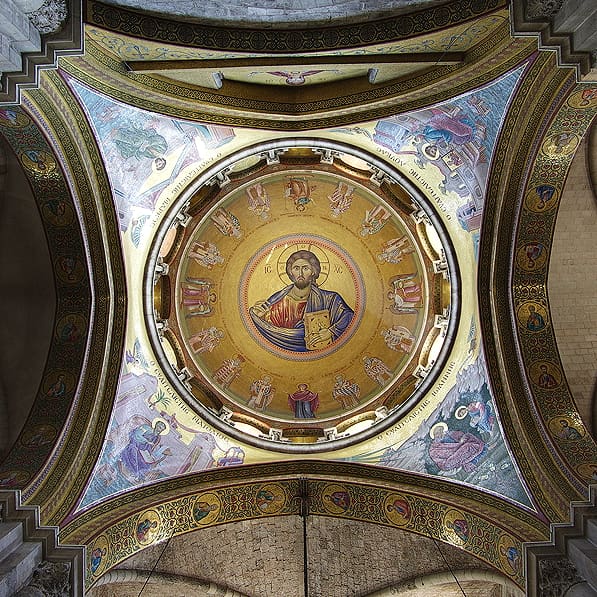 piece of the tomb of Jesus that is not covered by the aedicule.
piece of the tomb of Jesus that is not covered by the aedicule.
Opposite the aedicule, the Greek Orthodox faithful worship in the Catholicon, a magnificent space topped by a breathtaking dome, decorated with an image of Jesus surrounded by members of the heavenly host.
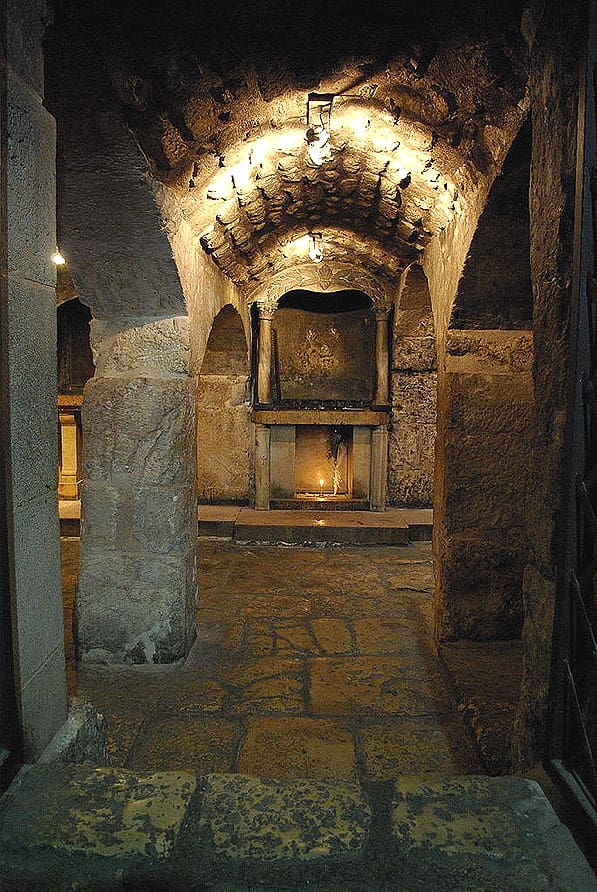 In a small chapel along the ambulatory behind the aedicule, a Syrian Orthodox chapel houses a tomb that dates to the first century and is believed to belong to St Joseph of Arimathea. The Catholic Chapel of Mary Magdalene commemorates the tradition that Jesus first appeared to His mother after His Resurrection. It houses a column that is said to have been the one on which He was tied during His scourging. Down a hallway with the Arches of Mary, pilgrims pass the remains of earlier churches built here. At the end of the hallway, the chapel of the Prison of Christ honors the early tradition
In a small chapel along the ambulatory behind the aedicule, a Syrian Orthodox chapel houses a tomb that dates to the first century and is believed to belong to St Joseph of Arimathea. The Catholic Chapel of Mary Magdalene commemorates the tradition that Jesus first appeared to His mother after His Resurrection. It houses a column that is said to have been the one on which He was tied during His scourging. Down a hallway with the Arches of Mary, pilgrims pass the remains of earlier churches built here. At the end of the hallway, the chapel of the Prison of Christ honors the early tradition 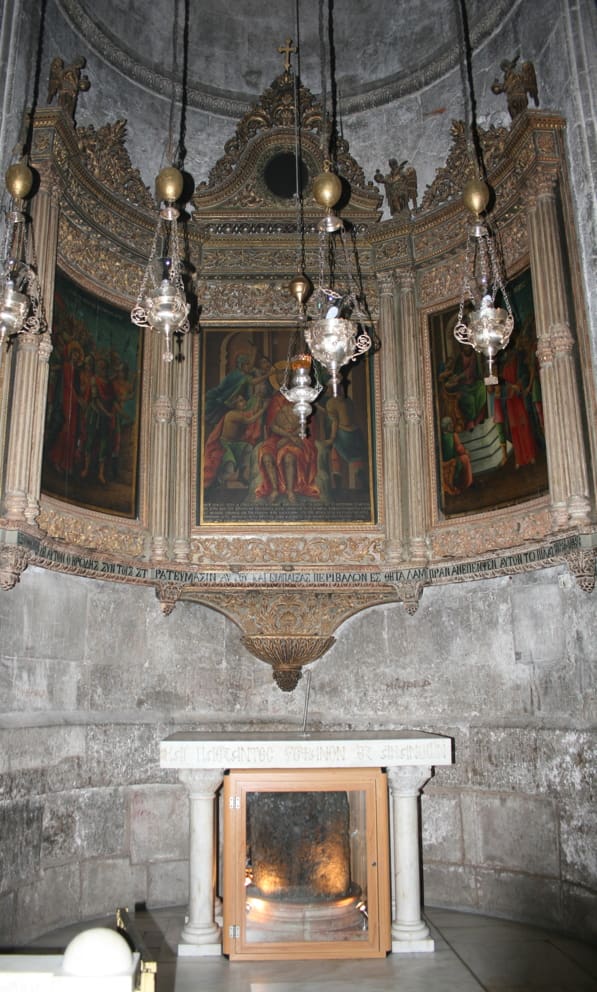 that Jesus was imprisoned here before His Crucifixion.
that Jesus was imprisoned here before His Crucifixion.
At the end of the church, opposite the tomb, pilgrims encounter three chapels: one honoring St. Longinus, the soldier who pierced Christ’s side with a spear; one remembering the division of Jesus’ robes; and one commemorating the mocking of Jesus by the Roman soldiers, housing a column said to have been where Jesus sat when the soldiers crowned His head with thorns.
 A stairway leads down to the Armenian chapel of St Helena, the oldest part of the church. More steps lead to the Chapel of the Finding of the Cross, where St Helena found the True Cross and other instruments of Jesus’ Passion and
A stairway leads down to the Armenian chapel of St Helena, the oldest part of the church. More steps lead to the Chapel of the Finding of the Cross, where St Helena found the True Cross and other instruments of Jesus’ Passion and 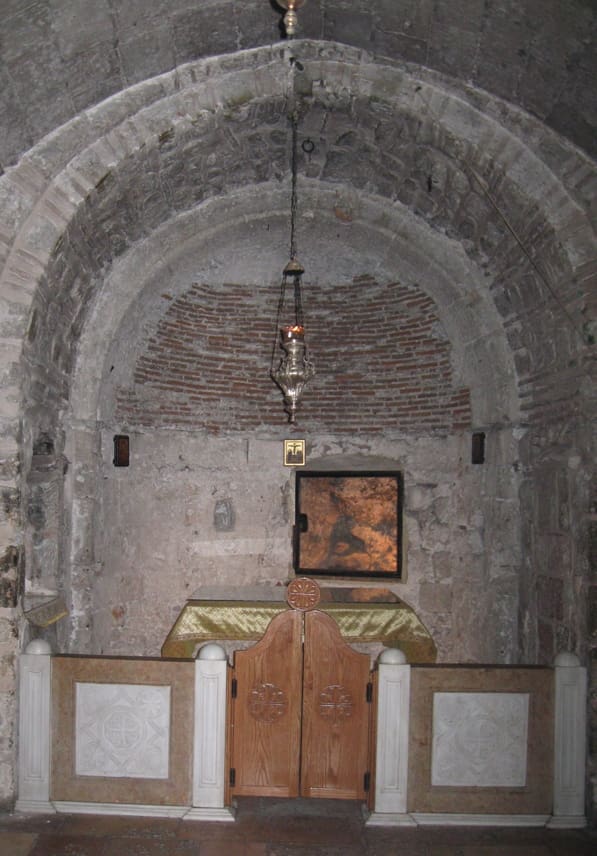 Crucifixion.
Crucifixion.
Back on the main floor, below the chapel of Calvary, the Chapel of Adam recalls the ancient tradition that Adam  was buried under Calvary. Behind the glass, pilgrims see the rock of Calvary, with a crack believed to have been caused by the earthquake that happened when Jesus died. Tradition holds that this crack allowed Jesus’ blood to trickle down into the earth and onto Adam’s bones, redeeming him.
was buried under Calvary. Behind the glass, pilgrims see the rock of Calvary, with a crack believed to have been caused by the earthquake that happened when Jesus died. Tradition holds that this crack allowed Jesus’ blood to trickle down into the earth and onto Adam’s bones, redeeming him.
For a closer look at this church and the other holy sights in the Holy Land, purchase the 2-DVD set of The Faithful Traveler in the Holy Land or join David and Diana on a pilgrimage to the Holy Land in March 2015. Check EWTN’s schedules for future broadcasts of The Faithful Traveler in the Holy Land.
The Faithful Traveler will be returning to the Holy Land in May 2014 to film a program about the Holy Father’s historic visit, entitled The Faithful Traveler: Preparing for the Pope in the Holy Land. Check The Faithful Traveler website for updates and regular posts before, during, and after their trip!
Art and Photography: Personal photography of Diana von Glahn, copyright, all rights reserved, used with permission. Other: Armenian Chapel of St. Helena, zvonimir atletic, 16 April 2009, CC; Chapel of Adam, Church of the Holy Sepulchre, Jerusalem, Ori~, own work, 23 July 2009, The copyright holder of this file allows anyone to use it for any purpose, provided that the copyright holder is properly attributed. Redistribution, derivative work, commercial use, and all other use is permitted; Chapel of St. Longinus, Church of the Holy Sepulchre, Jerusalem, poco a poco, own work, 28 September 2011, CC; Church of the Holy Sepulchre. Floor plan of the present church., own work Mh`as, PD-Worldwide; Church of the Holy Sepulchre, http://www.flickr.com/photos/jlascar/, 5 September 2012, CC; Holy Sepulchre Dome over the Katholikon Jerusalem, Berthold Werner, own work, 24 September 2010, CC; Holy Sepulchre Stairway to Golgotha, adriatikus, own work, 2008-01-23, CC; Marble canopy marking Station of the Holy Women, Deror avi, own work, 26 September 2008, CC; Prison of Christ, Berthold Werner, 10 November 2008, PD-Worldwide; The crack in the stone of Calvary (Golgotha), as seen from the Chapel of Adam, Church of the Holy Sepulchre, Jerusalem, adriatikus, 2008-01-23, CC; all Wikimedia Commons.



